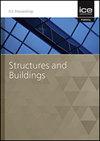On the mechanical model and seismic performance of frames with a self-centering connection
IF 1.4
4区 工程技术
Q3 CONSTRUCTION & BUILDING TECHNOLOGY
Proceedings of the Institution of Civil Engineers-Structures and Buildings
Pub Date : 2023-03-28
DOI:10.1680/jstbu.22.00233
引用次数: 0
Abstract
Regarding the approved desired structural performance of the self-centering pinned beam-column connections with friction dampers (SC-PC-FD), it is required to present an accurate mechanical model of SC-PC-FD connection for easy modelling of the frames with this type of connections using the common commercial structural analysis and design software. Therefore, this paper presents a simple mechanical model and verifies its accuracy considering the obtained results by experimental and numerical studies on 2-strand and 4-strand SC-PC-FD connections. Moreover, the seismic performance of the frames with SC-PC-FD connections was evaluated using incremental dynamic analysis and compared to moment-resisting frames. For this purpose, 1-, 3- and 5-story building models with moment and SC-PC-FD connections were designed, and two-dimensional frames were subjected to the considered far-field, pulse near-field, and no-pulse near-field earthquake records as per FEMA-P695 and then, the collapse margin ratio (CMR) and fragility curves of these models were obtained. It was concluded that the developed component-based mechanical model accurately predicted the monotonic and cyclic behaviour of SC-PC-FD connection. Moreover, the amount of maximum residual interstory drift ratio, along with the number of developed plastic hinges at the main members of self-centering models was reduced significantly, and the novel system achieved more CMR values.自定心连接框架的力学模型及抗震性能研究
针对经批准的带有摩擦阻尼器的自定心钉住梁柱连接(SC-PC-FD)的期望结构性能,要求给出SC-PC-FD连接的精确力学模型,以便使用通用的商业结构分析和设计软件对具有这种连接的框架进行建模。因此,本文提出了一个简单的力学模型,并结合2股和4股SC-PC-FD连接的实验和数值研究结果验证了其准确性。此外,使用增量动力分析对SC-PC-FD连接框架的抗震性能进行了评估,并与抗弯矩框架进行了比较。为此,设计了1层、3层和5层具有弯矩连接和SC-PC-FD连接的建筑模型,并按照FEMA-P695对二维框架进行了远场、脉冲近场和无脉冲近场地震记录,得到了这些模型的倒塌裕度比(CMR)和易脆性曲线。结果表明,所建立的基于构件的力学模型能够准确地预测SC-PC-FD连接的单调和循环性能。此外,自定心模型的最大剩余层间漂移比和主要构件塑性铰的开发数量显著减少,系统获得了更高的CMR值。
本文章由计算机程序翻译,如有差异,请以英文原文为准。
求助全文
约1分钟内获得全文
求助全文
来源期刊
CiteScore
3.40
自引率
6.20%
发文量
61
审稿时长
12 months
期刊介绍:
Structures and Buildings publishes peer-reviewed papers on the design and construction of civil engineering structures and the applied research associated with such activities. Topics include the design, strength, durability and behaviour of structural components and systems.
Topics covered: energy conservation, people movement within and around buildings, strength and durability of steel and concrete structural components, and the behaviour of building and bridge components and systems

 求助内容:
求助内容: 应助结果提醒方式:
应助结果提醒方式:


